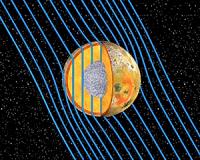 |
Pasadena CA (JPL) May 16, 2011 New data analysis from NASA's Galileo spacecraft reveals a subsurface ocean of molten or partially molten magma beneath the surface of Jupiter's volcanic moon Io. The finding heralds the first direct confirmation of this kind of magma layer at Io and explains why the moon is the most volcanic object known in the solar system. The research was conducted by scientists at the University of California, Los Angeles; the University of California, Santa Cruz;, and the University of Michigan, Ann Arbor. The study is published this week in the journal Science. "Scientists are excited we finally understand where Io's magma is coming from and have an explanation for some of the mysterious signatures we saw in some of the Galileo's magnetic field data," said Krishan Khurana, lead author of the study and former co-investigator on Galileo's magnetometer team at UCLA. "It turns out Io was continually giving off a 'sounding signal' in Jupiter's rotating magnetic field that matched what would be expected from molten or partially molten rocks deep beneath the surface." Io produces about 100 times more lava each year than all the volcanoes on Earth. While Earth's volcanoes occur in localized hotspots like the "Ring of Fire" around the Pacific Ocean, Io's volcanoes are distributed all over its surface. A global magma ocean about 30 to 50 kilometers (20 to 30 miles) beneath Io's crust helps explain the moon's activity. "It has been suggested that both the Earth and its moon may have had similar magma oceans billions of years ago at the time of their formation, but they have long since cooled," said Torrence Johnson, a former Galileo project scientist based at NASA's Jet Propulsion Laboratory in Pasadena, Calif. He was not directly involved in the study. "Io's volcanism informs us how volcanoes work and provides a window in time to styles of volcanic activity that may have occurred on the Earth and moon during their earliest history." NASA's Voyager spacecraft discovered Io's volcanoes in 1979, making that moon the only body in the solar system other than Earth known to have active magma volcanoes. The energy for the volcanic activity comes from the squeezing and stretching of the moon by Jupiter's gravity as Io orbits the largest planet in the solar system. Galileo was launched in 1989 and began orbiting Jupiter in 1995. Unexplained signatures appeared in magnetic field data from Galileo flybys of Io in October 1999 and February 2000. After a successful mission, the spacecraft was intentionally sent into Jupiter's atmosphere in 2003. "During the final phase of the Galileo mission, models of the interaction between Io and Jupiter's immense magnetic field, which bathes the moon in charged particles, were not yet sophisticated enough for us to understand what was going on in Io's interior," said Xianzhe Jia, a co-author of the study at the University of Michigan. Recent work in mineral physics showed that a group of rocks known as "ultramafic" rocks become capable of carrying substantial electrical current when melted. Ultramafic rocks are igneous in origin, or form through the cooling of magma. On Earth, they are believed to originate from the mantle. The finding led Khurana and colleagues to test the hypothesis that the strange signature was produced by current flowing in a molten or partially molten layer of this kind of rock. Tests showed that the signatures detected by Galileo were consistent with a rock such as lherzolite, an igneous rock rich in silicates of magnesium and iron found in Spitzbergen, Norway. The magma ocean layer on Io appears to be more than 50 kilometers (30 miles thick), making up at least 10 percent of the moon's mantle by volume. The blistering temperature of the magma ocean probably exceeds 1,200 degrees Celsius (2,200 degrees Fahrenheit). The Galileo mission was managed by JPL for NASA's Science Mission Directorate in Washington. JPL is a division of the California Institute of Technology in Pasadena.
Share This Article With Planet Earth
Related Links Galileo mission Jupiter and its Moons Explore The Ring World of Saturn and her moons The million outer planets of a star called Sol News Flash at Mercury
 NASA's Galileo reveals magma 'ocean' beneath surface of Jupiter's moon
NASA's Galileo reveals magma 'ocean' beneath surface of Jupiter's moonWashington DC (SPX) May 13, 2011 A new analysis of data from NASA's Galileo spacecraft has revealed that beneath the surface of Jupiter's volcanic moon Io is an "ocean" of molten or partially molten magma. The finding, from a study published in the journal Science, is the first direct confirmation of such a magma layer on Io and explains why the moon is the most volcanic object known in the solar system. The research was ... read more |
|
| The content herein, unless otherwise known to be public domain, are Copyright 1995-2010 - SpaceDaily. AFP and UPI Wire Stories are copyright Agence France-Presse and United Press International. ESA Portal Reports are copyright European Space Agency. All NASA sourced material is public domain. Additional copyrights may apply in whole or part to other bona fide parties. Advertising does not imply endorsement,agreement or approval of any opinions, statements or information provided by SpaceDaily on any Web page published or hosted by SpaceDaily. Privacy Statement |